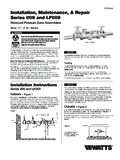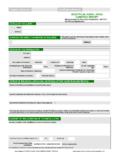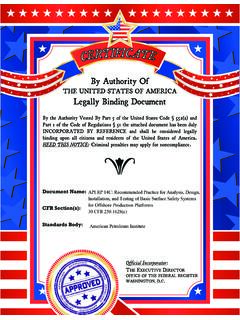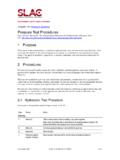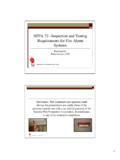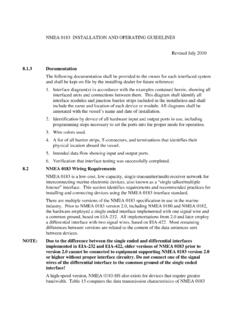Transcription of Chapter 7 Inspection, Evaluation, and Testing
1 SPCC GUIDANCE FOR REGIONAL INSPECTORS 7-1 December 16, 2013 Chapter 7 inspection , evaluation , and Testing Introduction The inspection , evaluation and Testing requirements of the SPCC rule are intended to prevent, predict and detect potential integrity or structural issues before they cause a leak, spill or discharge of oil to navigable waters or adjoining shorelines. Regularly scheduled inspections, evaluations, and Testing by qualified personnel are critical parts of oil discharge prevention. They are conducted not only on containers, but also on associated piping, valves, and appurtenances, and on other equipment and components that could be a source or cause of an oil discharge. Activities may involve one or more of the following: an external visual inspection of containers, piping, valves, appurtenances, foundations, and supports; a non-destructive Testing (examination) to evaluate integrity of certain containers; and additional evaluations, as needed, to assess the equipment s fitness for continued service.
2 The type of inspection program and its scope will depend on site-specific conditions and the application of good engineering practices, adherence to applicable industry standards and/or manufacturer s requirements. An inspection , evaluation , and Testing program that complies with SPCC requirements should specify the procedures, schedule/frequency, types of equipment covered, person(s) conducting the activities, recordkeeping practices, and other elements as outlined in this Chapter . The remainder of this Chapter is organized as follows: Section provides an overview of the SPCC inspection , evaluation , and Testing requirements. Section discusses the role of industry standards and recommended practices in meeting SPCC requirements. Section discusses determining a baseline in order to establish a regular inspection schedule. Section presents special circumstances, including the use of environmentally equivalent measures.
3 This section also includes suggested minimum requirements for a hybrid inspection program. Section discusses the role of the EPA inspector in reviewing a facility s compliance with the rule s inspection , evaluation , and Testing requirements. Section summarizes industry standards, code requirements, and recommended practices (RPs) that apply to different types of equipment. SPCC GUIDANCE FOR REGIONAL INSPECTORS 7-2 December 16, 2013 Chapter 7: inspection , evaluation , and Testing inspection , evaluation , and Testing under the SPCC Rule Various provisions of the SPCC rule relate to the inspection , evaluation , and Testing of containers, associated piping, and other oil-containing equipment. Different requirements apply to different types of equipment, oil, and facilities. The requirements are generally aimed at preventing discharges of oil caused by leaks, corrosion, brittle fracture, overfill, or other forms of container or equipment failure by ensuring that containers used to store oil have the necessary physical integrity for continued oil storage.
4 The requirements are also aimed at detecting container and equipment failures (such as pinhole leaks) before they can become significant and result in a discharge as described in (b). Summary of inspection , evaluation and Integrity Testing Requirements Table 7-1 summarizes the provisions that apply to different types of equipment and facilities. As shown in the table, applicable inspection and Testing provisions vary depending on the type of equipment, facility, and circumstances. For example, some inspection and Testing provisions apply specifically to bulk storage containers at onshore facilities (other than oil production facilities) while other inspection and/or Testing requirements apply to other components of a facility that might cause a discharge (such as vehicle drains, foundations, or other equipment or devices). Animal fat and vegetable oil (AFVO) containers that meet certain criteria are eligible for differentiated integrity Testing requirements.
5 Onshore oil production facilities have a distinct set of inspection requirements including minimum expectations for a flowline maintenance program. The SPCC rule also includes regulatory alternatives to sized secondary containment that include inspection and corrective action requirements. Finally, additional requirements apply under certain circumstances, such as when an aboveground field-constructed container undergoes repairs, alterations, or a change in service that may affect its potential for a brittle fracture or other catastrophic failure, or in cases where secondary containment for bulk storage containers is impracticable ( (d), as described in Chapter 4: Secondary Containment and Impracticability). Facility owners and operators must maintain records to demonstrate compliance with the inspection , evaluation , and integrity Testing requirements per (e).
6 SPCC GUIDANCE FOR REGIONAL INSPECTORS 7-3 December 16, 2013 Chapter 7: inspection , evaluation , and Testing Table 7-1: Summary of SPCC inspection , evaluation , and integrity Testing program provisions and associated recordkeeping requirements. Facility Component Section(s) Action Method, Circumstance, and Required Action (Text in italics indicates the frequency or circumstances for performing the activity, as specified in the SPCC rule.) General Requirements Applicable to All Facilities Bulk storage containers with no secondary containment and for which an impracticability determination has been made (d) Test Integrity Testing . Periodically. Integrity Testing is required for all bulk storage containers. In cases where no secondary containment is present because it is impracticable, good engineering practice may suggest more frequent Testing than would otherwise be scheduled.
7 Note that this includes bulk storage containers at oil production, drilling and workover facilities that are not typically subject to integrity Testing requirements. Valves and piping associated with bulk storage containers with no secondary containment and for which an impracticability determination has been made (d) Test Integrity and leak Testing of valves and piping associated with containers that have no secondary containment as described in (c). Periodically. Recordkeeping requirement (e) Record Keep written procedures and a signed record of inspections105 and tests for a period of three Records kept under usual and customary business practices will suffice. For all actions. Lowermost drain and all outlets of tank car or tank truck at loading/unloading racks (h)(3) Inspect Visually inspect. Prior to filling and departure of tank car or tank truck from loading/unloading racks.
8 105 Inspections include evaluations ( brittle fracture evaluation ) required under the regulation. 106 Certain industry standards require recordkeeping beyond three years. Facility owners/operators should keep comparison records of integrity inspections and tests as directed in the standard, but no less than three years in accordance with the SPCC record retention requirement, in order to identify changing conditions of the oil storage container. EPA recommends that formal Testing and inspection records or reports be retained for the life of the container. SPCC GUIDANCE FOR REGIONAL INSPECTORS 7-4 December 16, 2013 Chapter 7: inspection , evaluation , and Testing Facility Component Section(s) Action Method, Circumstance, and Required Action Field-constructed aboveground container (i) Evaluate Corrective Action Evaluate potential for brittle fracture or other catastrophic failure.
9 When the container undergoes a repair, alteration, reconstruction or a change in service that might affect the risk of a discharge or failure due to brittle fracture or other catastrophe, or has discharged oil or failed due to brittle fracture failure or other catastrophic failure. Based on the results of this evaluation , take appropriate action. Onshore Facilities (Excluding Oil Production Facilities)P107 Diked areas (b)(1) & (b)(2) or (b)(1) & (b)(2)108 Inspect Record Visually inspect content for presence of oil when draining into a watercourse. Prior to draining. Keep adequate records of such events. Diked areas for bulk storage containers (c)(3) & (c)(3) Inspect Record Inspect retained rainwater to ensure that it will not cause a discharge as described in (b) when draining to storm sewer or open watercourse, lake or pond. Prior to draining. Keep adequate records of such events.
10 Buried metallic storage tank installed on or after January 10, 1974 (c)(4) or (c)(4) Test Leak test. Regularly Aboveground bulk storage container (c)(6) or (c)(6) Test or Inspect Test or inspect each container for integrity. Following a regular schedule and whenever material repairs are made. Determine scope, frequency of Testing and qualification of personnel performing the test or inspection , in accordance with industry standards. Tests include, but are not limited to, visual inspection , hydrostatic Testing or other non-destructive Testing . Aboveground bulk storage container (c)(6) or (c)(6) Inspect Inspect outside of container for signs of deterioration and discharges. Frequently. Aboveground bulk storage container supports and foundations (c)(6) or (c)(6) Inspect Inspect container s supports and foundations. Following a regular schedule and whenever material repairs are made.










